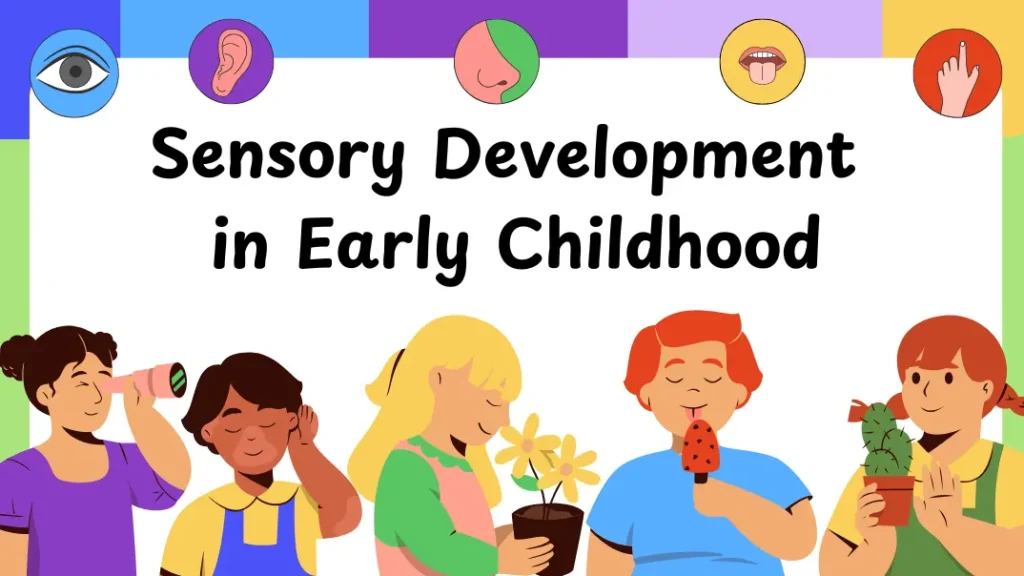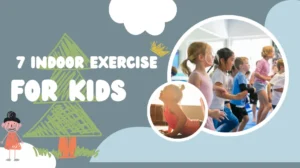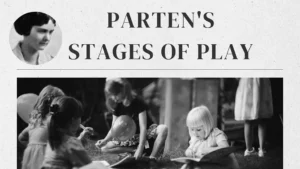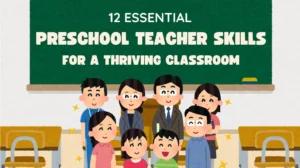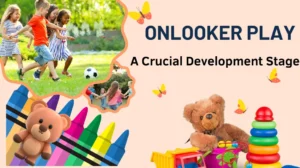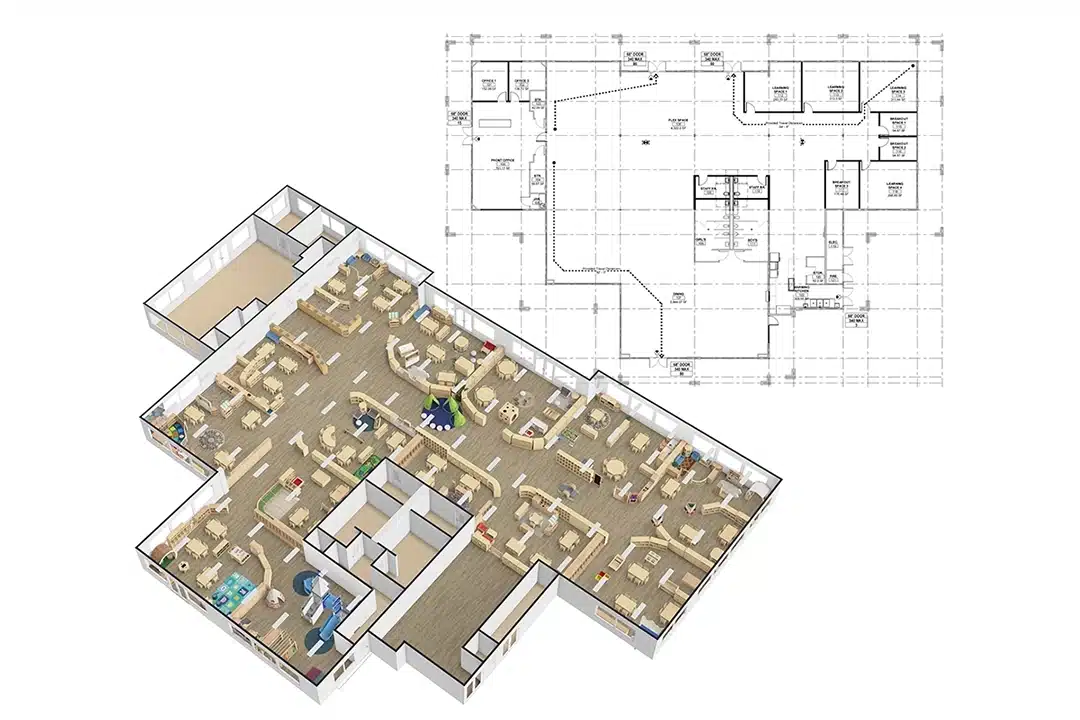Have you ever wondered why sensory development is so important in early childhood? How does it impact a child’s learning and growth? As a parent or educator, you might wonder what role sensory activities play in preparing children for school and life. Are you looking for ways to safely and effectively support your preschoolers’ sensory growth?
Sensory development is a crucial aspect of a child’s early learning journey. It affects how they interact with the world around them and their cognitive, motor, and emotional growth. Educators and caregivers engage children’s senses to provide the foundation for critical life skills.
This comprehensive guide will explore the different types of sensory development, how they affect young children, and practical ways to enhance sensory experiences during the crucial early years.
What Are Sensory Processing Skills?
Sensory processing skills refer to an individual’s ability to take in sensory input from the environment, interpret it, and respond meaningfully. These skills involve integrating sensory information from sight, sound, touch, smell, taste, and movement into cohesive thoughts and actions.
When children experience sensory stimuli, their brains must process and make sense of the information, guiding actions and responses. Children with well-developed sensory processing skills can efficiently interpret their environment, while those with sensory processing challenges may struggle with everyday activities like eating, dressing, or interacting socially.
Developing strong sensory processing skills is essential for children. These skills help them interact with their surroundings and build foundational life skills. Children with strong sensory processing abilities are better equipped to understand their environment, communicate, and engage in various activities, forming the basis for cognitive and social development.
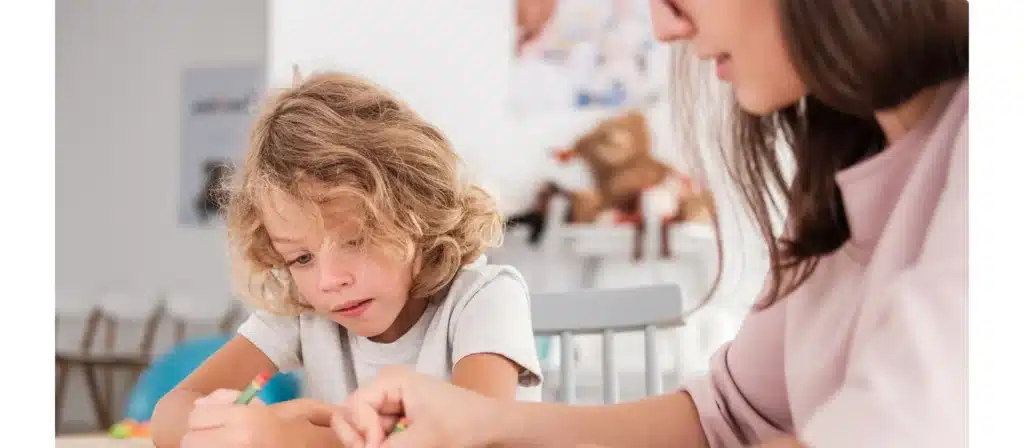
8 Sensory Development Systems
Sensory development includes more than the traditional five senses—sight, sound, touch, smell, and taste—it also involves other systems that help children navigate their world, such as the vestibular (balance) and proprioception (body awareness) systems.
1. Visual Development
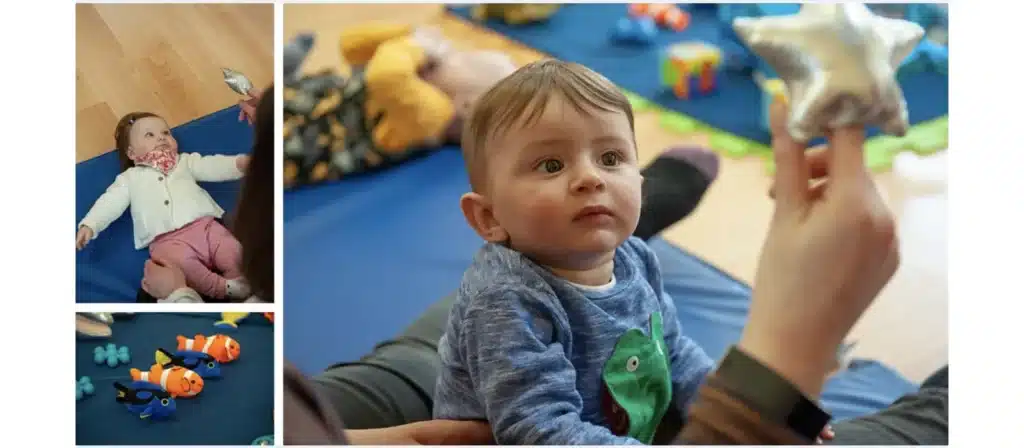
Visual development begins early in infancy, starting with the ability to focus on objects and recognize faces. Over time, babies start to track objects with their eyes, develop depth perception, and refine their ability to recognize and distinguish different shapes and colors. Healthy visual development is important for learning, especially for activities like reading and writing.
2. Auditory Development
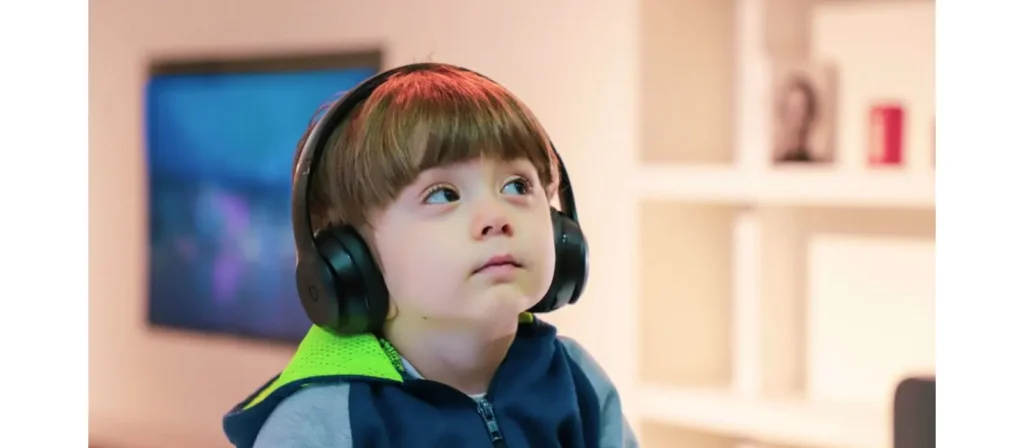
Hearing is another vital sense that develops in the womb, with babies recognizing sounds soon after birth. Auditory development allows children to interpret language, hear and distinguish between different sounds, and develop the foundations for communication. This sense is key to social interactions and emotional bonding, as hearing a caregiver’s voice or a familiar sound brings comfort to a child.
3. Tactile (Touch) Development
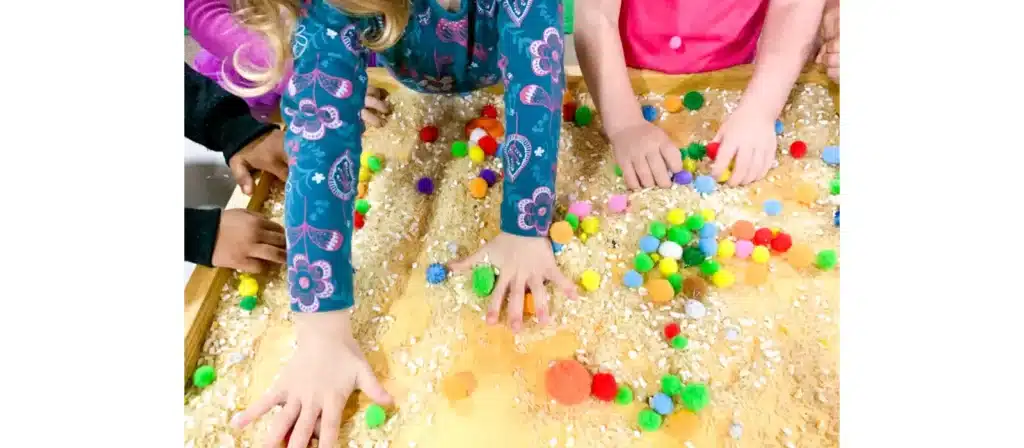
The sense of touch is one of the first senses to develop. Tactile experiences help infants develop motor skills, body awareness, and emotional regulation. Touch is essential for building relationships and fostering child and caregiver bonding. From the feel of a soft blanket to the texture of different objects, tactile experiences fundamentally influence a child’s sensory development.
4. Olfactory (Smell) Development
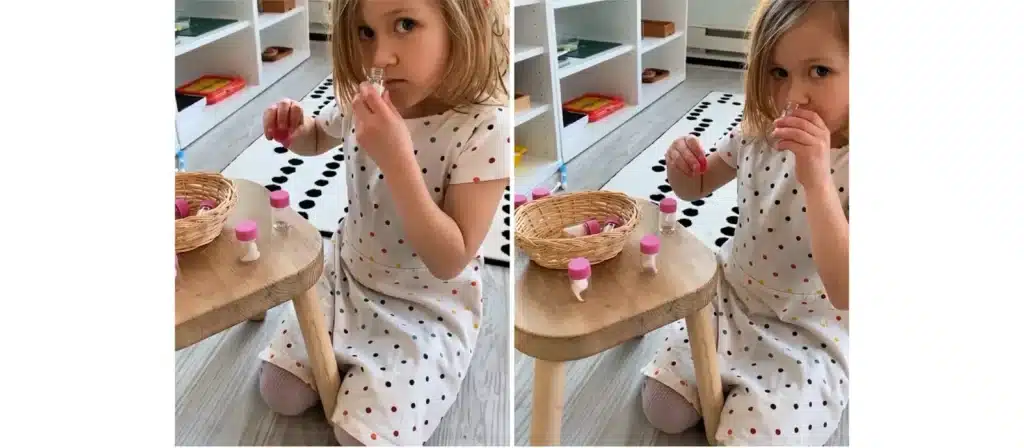
Smell plays a surprisingly important role in early childhood development. Babies begin to develop their sense of smell from birth, and by three to four months, they can differentiate between various odors. The smell is closely linked to memory and emotional responses, as certain smells can evoke comfort, calm, or stress in children.
5. Gustatory (Taste) Development

Taste development is intertwined with a child’s feeding experiences. Children begin to develop preferences and aversions by introducing different tastes early on. Early exposure to various flavors can influence a child’s food choices later in life. A healthy sense of taste is also important for sensory development because it helps children understand the textures and qualities of their food.
6. Developing Vestibular Senses
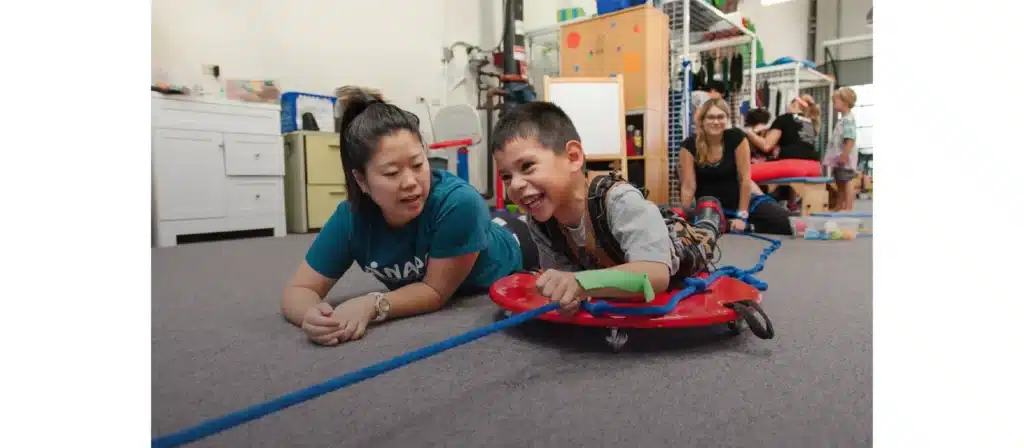
The vestibular system in the inner ear helps children maintain balance and orientation. It allows children to coordinate their crawling, walking, or jumping movements. Vestibular experiences also contribute to spatial awareness and the development of motor skills.
7. Developing Proprioception
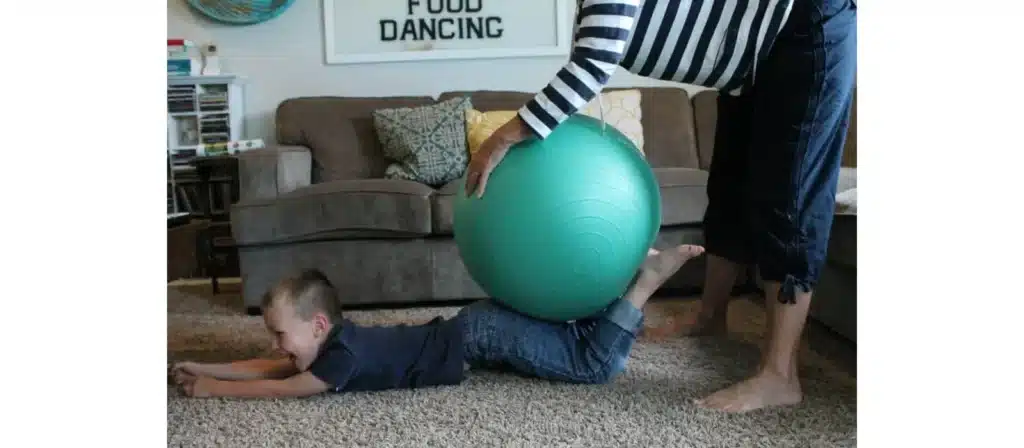
Proprioception refers to the ability to sense the position of one’s body in space. This sense helps children with motor coordination and allows them to engage in climbing, balancing, and navigating obstacles. Developing proprioceptive awareness is crucial for building strength, coordination, and body control.
8. Interoception
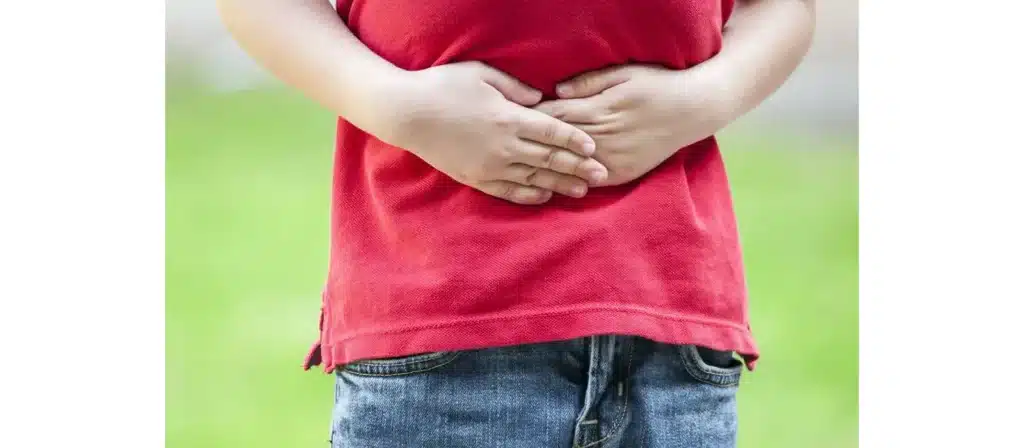
Interoception is the ability to sense internal body signals, such as hunger, thirst, and the need to use the bathroom. Developing interoception is essential for self-regulation and emotional health. Children with strong interoceptive awareness can better recognize when they need a break or when something feels wrong physically or emotionally.
Why is Sensory Development Important?
Sensory development is key in building a child’s cognitive, emotional, and physical skills. It influences how children explore, understand, and interact with the world. Through sensory experiences, children can gather information, focus attention, and fully engage with their surroundings. Sensory development is the foundation upon which all learning and growth are built, making it a crucial aspect of early childhood education.
- Gathering Information
Children’s ability to gather information about their environment relies heavily on their sensory experiences. From birth, children begin interpreting the world through their senses, whether it’s the feel of an object, the sound of a voice, or the sight of a parent’s face. Children process this sensory input more efficiently as they grow, which helps cognitive development and learning. - Exploring the World
Exploration is a key component of sensory development. Children can interact with objects, people, and their surroundings through sensory play. This fosters learning and helps children develop curiosity and problem-solving skills. Sensory exploration is crucial for understanding spatial relationships, cause-and-effect dynamics, and other foundational concepts. - Attention and Focus
Proper sensory development enhances a child’s ability to focus on tasks and stay attentive to their surroundings. As children process sensory input, they better filter out irrelevant stimuli and focus on important cues, critical for academic success later in life. - Full Engagement
Sensory development encourages children to engage fully in the present moment, fostering mindfulness and emotional regulation. Fully engaged children tend to be more present in their activities and better able to process new information.
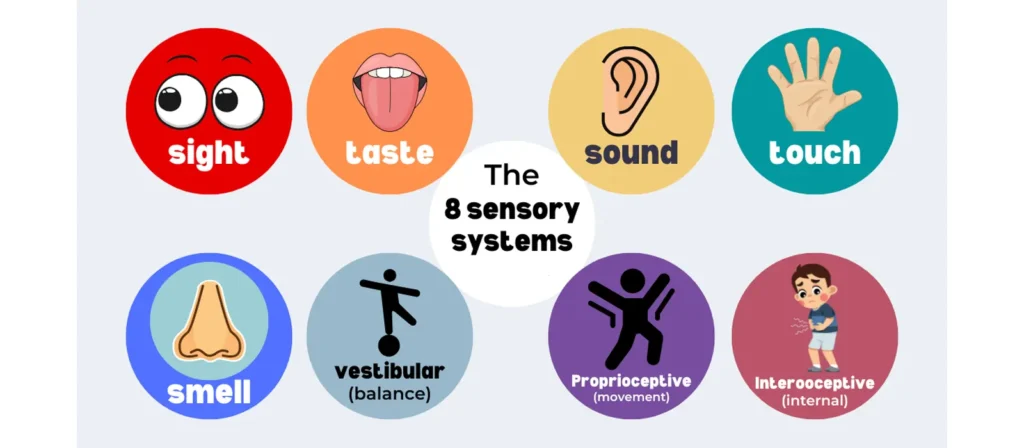
Stages of Sensory Development
Understanding the stages of sensory development can help parents and educators gauge whether a child’s sensory abilities are developing as expected. These stages outline the growth and milestones related to sensory processing from birth to age five.
0 to 3 months
In this early phase, babies are just beginning to process sensory information. Their primary mode of engagement with the world is through reflexive responses to stimuli, but this period is crucial for laying the foundation for future sensory development.
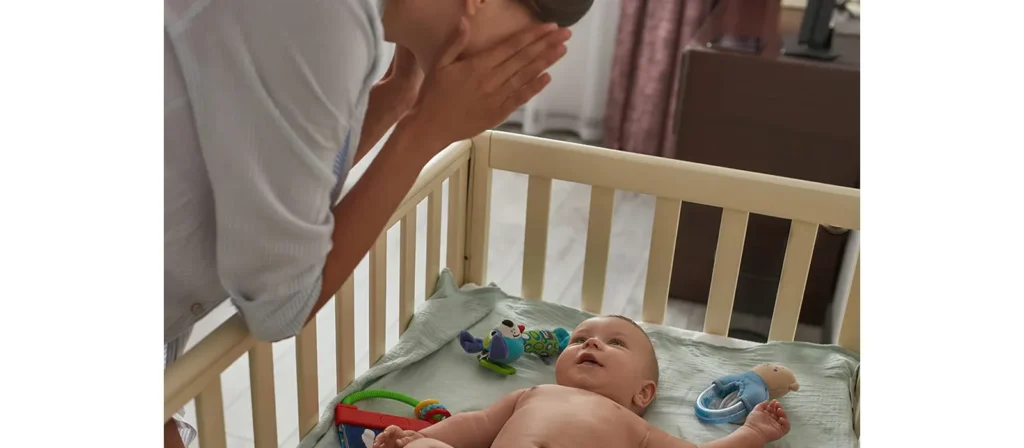
Visual Development:
At this stage, babies are just beginning to focus on objects and faces. Their visual range is limited, but they can focus on objects about 8-12 inches away, primarily recognizing high-contrast patterns like black and white.
- Typical Process:
- Focus on high-contrast patterns (e.g., black and white).
- Recognize familiar faces and objects.
- Limited tracking ability, mainly for slow-moving objects.
- Activities to Promote Sensory Development:
- To engage the baby’s attention, place high-contrast black-and-white images or toys in front of it.
- Hold the baby at a comfortable distance (about 8-12 inches) from your face to encourage face recognition.
- Use colorful, large-patterned toys to encourage visual tracking slowly.
Auditory Development:
Babies begin to process sounds with a heightened sensitivity to the human voice. They can hear but mostly respond to sudden noises or their caregivers’ voices, which helps them feel secure.
- Typical Process:
- Startle response to loud noises.
- Calm or become alert to familiar voices, especially the caregiver’s.
- Begin responding to different pitches and tones.
- Activities to Promote Sensory Development:
- Talk, sing, or read to the baby using varied tones and pitches to encourage auditory exploration.
- Use soothing sounds, like lullabies or white noise, to help comfort them.
- Gently rattle a toy near the baby to introduce sound variation.
Taste Development:
Taste buds are functional from birth, and babies naturally prefer sweet flavors, particularly from breast milk or formula.
- Typical Process:
- Preference for sweet flavors.
- Ability to differentiate basic tastes like sweet or sour.
- Exploration of taste as solids are gradually introduced.
- Activities to Promote Sensory Development:
- Offer breast milk or formula, which encourages the development of taste preferences.
- When appropriate, introduce pureed fruits to expose the baby to new flavors.
Olfactory Development:
Newborns are highly sensitive to smells and are particularly drawn to familiar scents, such as their caregiver’s scent.
- Typical Process:
- Reacts to familiar scents, like the caregiver’s skin or milk.
- Babies may respond positively or negatively to different odors.
- Activities to Promote Sensory Development:
- Keep the baby close to you, letting them become familiar with your scent.
- Introduce gentle, calming fragrances like lavender or vanilla.
Touch Development:
Touch is the most developed sense at birth, and babies respond strongly to tactile stimulation. Skin-to-skin contact and gentle touch are comforting and bonding experiences.
- Typical Process:
- Strong reflexive reactions to touch.
- Immediate comfort from soft, familiar contact, such as being held or swaddled.
- Activities to Promote Sensory Development:
- Use frequent skin-to-skin contact to promote emotional bonding and tactile development.
- Gently massage the baby’s hands and feet using soft, calming strokes.
Vestibular Development:
At this stage, vestibular (balance) development is very limited. However, babies can start experiencing movement through being held and rocked.
- Typical Process:
- Basic response to movement (rocking, being cradled).
- No control over balance or movement.
- Activities to Promote Sensory Development:
- Gently rock or sway the baby to stimulate vestibular responses.
- Hold the baby in a semi-upright position to experience slight movements in different directions.
Proprioception Development:
Newborns have a basic awareness of their body and movements. Their proprioceptive sense (awareness of body position) is rudimentary at birth but begins to develop through movement and touch.
- Typical Process:
- Reflexive movements such as grasping or kicking.
- Limited awareness of body position.
- Activities to Promote Sensory Development:
- Encourage tummy time to help develop body awareness and strength.
- Gently hold the baby in different positions to stimulate sensory awareness of their body in space.
3 to 6 months
During this stage, babies start becoming more aware of their surroundings and begin using their senses to explore the world actively. Their movements become more deliberate, and they show increased interest in engaging with their environment.
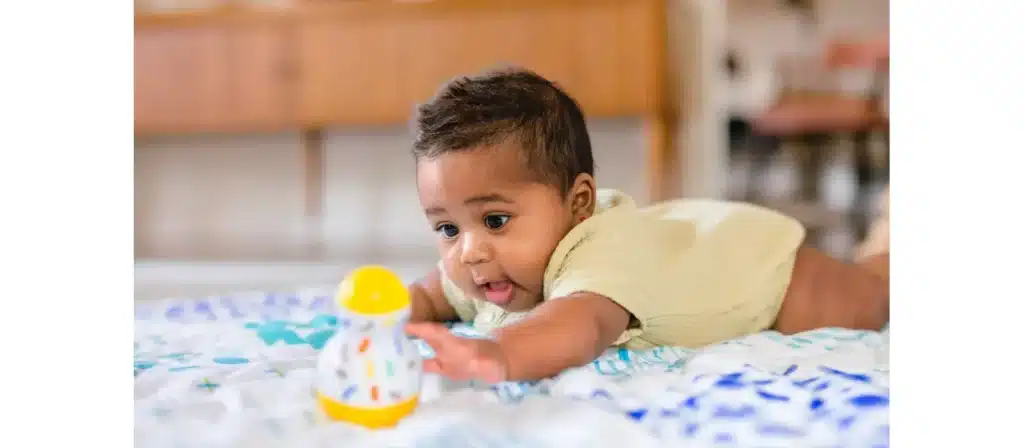
Visual Development:
Vision continues to improve. Babies can now track moving objects and show interest in colorful toys and patterns.
- Typical Process:
- Can focus on objects at varying distances.
- Begins tracking fast-moving objects.
- Start recognizing and differentiating primary colors.
- Activities to Promote Sensory Development:
- Introduce brightly colored toys or picture books to catch the baby’s attention.
- Use toys that move to encourage visual tracking, such as a ball or a toy that rolls.
- Hold the baby up to mirrors to help them recognize their reflection.
Auditory Development:
Babies begin to show more advanced auditory responses, turning towards sounds and even responding to their names.
- Typical Process:
- Turns head towards familiar sounds.
- Start to babble, imitating sounds.
- Reacts to environmental noises like a dog barking or the sound of a doorbell.
- Activities to Promote Sensory Development:
- Play sound-based toys, such as rattles, bells, or music boxes, to engage the auditory system.
- Encourage baby to mimic sounds or respond to your voice with babbling.
- Play rhythmic music to introduce different auditory patterns.
Taste Development:
By now, babies may be starting to enjoy a variety of solid foods, including mashed fruits and vegetables.
- Typical Process:
- Enjoy a wider variety of flavors.
- Show preferences for certain foods.
- Begin developing the ability to chew softer foods.
- Activities to Promote Sensory Development:
- Introduce a variety of new tastes and textures, such as pureed vegetables, fruits, and cereals.
- Allow the baby to explore self-feeding using soft finger foods.
Olfactory Development:
Babies react to environmental smells, such as food or different fragrances. They may show preferences for familiar or comforting smells.
- Typical Process:
- Reactions to new smells, both positive and negative.
- Recognizes and responds to familiar scents, such as their caregiver’s scent.
- Activities to Promote Sensory Development:
- Let the baby explore new smells such as flowers, food, or essential oils (always ensure safety with natural products).
- Use familiar scents like the scent of their clothing to promote comfort.
Touch Development:
Tactile sensitivity improves, and babies begin to explore different textures more actively.
- Typical Process:
- Reach for and manipulate objects with hands.
- Enjoy tactile exploration through grabbing, mouthing, and handling objects.
- Activities to Promote Sensory Development:
- Offer textured toys or soft objects to explore.
- Allow the baby to play with soft fabrics, rubber toys, or objects that offer varied tactile experiences.
Vestibular Development:
Babies begin gaining better control over their movements and enjoy activities involving gentle movement.
- Typical Process:
- Develop head and neck control.
- Enjoy being rocked or bounced.
- May start to sit up with support.
- Activities to Promote Development:
- Play gentle rocking or bouncing games to enhance balance.
- Help the baby sit up with support or assist them in standing to develop spatial awareness and balance.
Proprioception Development:
Babies develop more control over their limbs and begin to move with purpose.
- Typical Process:
- Begin to explore different positions, like reaching or pushing up during tummy time.
- Increased coordination of hand-eye and hand-body movements.
- Activities to Promote Sensory Development:
- Encourage tummy time and play that involves reaching for objects.
- Allow the baby to grab toys and explore with both hands to refine proprioceptive awareness.
6 to 12 months
As babies approach their first year, they grow increasingly mobile and curious, exploring their environment and refining their sensory processing. This period marks significant motor control, balance, and sensory awareness milestones.

Visual Development:
By this stage, babies develop the ability to focus and track objects across a wider field of vision. Their depth perception improves, and they show interest in smaller details.
- Typical Process:
- Can track fast-moving objects with eyes.
- Improved depth perception and visual focus.
- Recognize more complex visual cues, such as faces and objects.
- Activities to Promote Sensory Development:
- Play with moving toys or objects to encourage tracking.
- Introduce picture books with small details for the baby to focus on.
- Play peekaboo games to reinforce recognition and visual interaction.
Auditory Development:
By now, babies can understand and respond to basic language. They start imitating sounds and vocalizing more frequently.
- Typical Process:
- Begin to respond to their name.
- Babbling becomes more varied.
- Reacts to environmental sounds and voices.
- Activities to Promote Sensory Development:
- Play sound-based games like singing or clapping games to promote auditory engagement.
- Encourage imitation of simple words or sounds.
Taste Development:
With the introduction of solids, babies explore a variety of textures and flavors, and their preferences begin to solidify.
- Typical Process:
- Enjoy a greater variety of tastes, including salty and sour.
- Develop the ability to chew soft foods.
- Show preferences for specific tastes.
- Activities to Promote Sensory Development:
- Continue introducing solid foods of varying textures.
- Encourage self-feeding with soft, cut-up foods to promote independence.
Olfactory Development:
Babies at this stage are more sensitive to different smells and may express reactions to both pleasant and unpleasant odors.
- Typical Process:
- Distinguish between different scents.
- Show preferences for certain smells.
- Activities to Promote Sensory Development:
- Introduce a variety of new, safe scents (e.g., citrus or lavender).
- Use familiar scents like vanilla or flowers to comfort the baby.
Touch Development:
Babies engage more actively with their environment through tactile exploration, improving their fine motor skills and sensory discrimination.
- Typical Process:
- Begin manipulating objects with greater control.
- Explore different textures and surfaces with hands and mouth.
- Activities to Promote Sensory Development:
- Provide various toys with different textures for tactile stimulation.
- Encourage playing with objects like squishy balls or textured fabrics.
Vestibular Development:
By this stage, babies have better balance and coordination, and they begin to enjoy activities that challenge their balance.
- Typical Process:
- Sit up independently and start crawling.
- Enjoy movement like bouncing, rocking, or swinging.
- Activities to Promote Sensory Development:
- Encourage crawling or cruising around furniture to build strength and balance.
- Introduce a baby swing or rocking chair to stimulate vestibular development.
Proprioception Development:
Babies have better control over their body movements, with an emerging sense of where their body is in space.
- Typical Process:
- Improved coordination when reaching, grabbing, or pushing objects.
- Gaining the ability to balance independently while sitting or standing with support.
- Activities to Promote Sensory Development:
- Encourage sitting, standing with support, or walking with assistance.
- Provide toys that encourage reaching and bending.
1 to 2 years
Children are rapidly developing their motor skills at this stage, and their sensory systems are becoming more refined. They are increasingly independent in exploring their environment and engaging with the world around them.
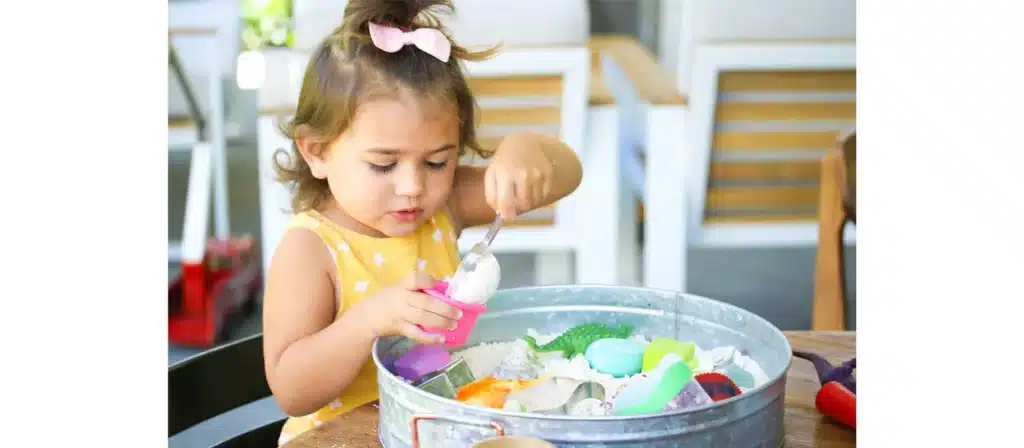
Visual Development:
Children can now see objects in greater detail and from further away. They are beginning to develop depth perception and can recognize more subtle differences in colors, shapes, and sizes.
- Typical Process:
- Improved visual tracking of fast-moving objects.
- Can recognize more colors and shapes.
- Begin to recognize and distinguish between familiar and unfamiliar objects at greater distances.
- Activities to Promote Sensory Development:
- Encourage shape-sorting activities with colorful blocks or toys.
- Provide picture books with detailed images and colorful illustrations.
- Engage the child in games that involve hiding objects and asking them to find them to encourage visual searching and recognition.
Auditory Development:
Children’s ability to respond to sound improves, and they begin understanding the meaning of simple words and phrases. They also start using more varied sounds and may even combine words into simple sentences.
- Typical Process:
- Begin responding to their name.
- Understand simple words or commands (e.g., “come here,” “no”).
- Can distinguish between different environmental sounds and react to them.
- Activities to Promote Sensory Development:
- Engage in frequent conversations with the child, encouraging them to repeat words and phrases.
- Play auditory games like clapping or stomping to emphasize sound recognition.
- Introduce rhyming books or songs to encourage auditory processing and language development.
Taste Development:
Taste preferences become more defined, and toddlers may begin to refuse certain foods or develop a strong liking for others. They are also becoming more sensitive to food textures.
- Typical Process:
- Stronger preference for certain flavors and textures.
- May start showing resistance to some foods.
- Begin to distinguish between sweet, sour, salty, and bitter tastes.
- Activities to Promote Sensory Development:
- Offer a wide variety of healthy foods to help the child develop balanced taste preferences.
- Encourage self-feeding to allow them to explore food textures and tastes independently.
- Let the child explore new flavors through safe food experiments like tasting lemon slices or trying different fruits.
Olfactory Development:
Children’s sense of smell continues to mature. They may begin associating certain smells with memories or feelings, such as a favorite food or their caregiver’s scent.
- Typical Process:
- More responsive to strong smells.
- May show preferences for or against certain scents, particularly food-related smells.
- Can begin to recognize familiar scents, such as their favorite soap or food.
- Activities to Promote Sensory Development:
- Introduce scent-rich experiences like smelling flowers or fresh fruit.
- Use scents in play activities, such as baking cookies or playing with scented playdough.
- Let the child interact with natural smells (e.g., herbs, vanilla, lavender) to stimulate olfactory responses.
Touch Development:
At this stage, children refine their fine motor skills, becoming more skilled at manipulating objects and exploring their environment with greater precision.
- Typical Process:
- Can manipulate objects more precisely (e.g., stacking blocks, using spoons or forks).
- Begin to differentiate between different textures and materials (soft, rough, smooth, etc.).
- Increased interest in tactile exploration through touching and grabbing.
- Activities to Promote Sensory Development:
- Provide a variety of tactile toys with different textures (soft toys, textured balls, fabric books).
- Encourage finger painting or playing with kinetic sand to develop tactile sensitivity.
- Set up sensory bins filled with materials like rice, beans, or pasta for tactile exploration.
Vestibular Development:
Children gain more control over their balance and coordination, enabling them to explore their environment more freely. Their ability to engage in movement-based activities increases.
- Typical Process:
- Improved balance and posture.
- Enjoy physical play like climbing, jumping, and running.
- May start to dance or move rhythmically to music.
- Activities to Promote Sensory Development:
- Engage in physical activities such as dancing, jumping, or climbing soft play equipment.
- Play games that involve balance, such as walking on a line or hopping.
- Allow time for free play that encourages crawling, running, and other movements to promote vestibular development.
Proprioception Development:
The child’s awareness of their own body in space becomes more refined. They begin to understand how their body moves and starts to control their physical movements with greater purpose.
- Typical Process:
- Improved body awareness and coordination.
- Begin to learn more complex motor tasks such as running or jumping.
- Increased awareness of body position in space, such as crawling or standing.
- Activities to Promote Sensory Development:
- Encourage activities like climbing stairs, crawling through tunnels, or balancing on low beams to improve body awareness.
- Provide opportunities for climbing, jumping, or lifting objects to enhance proprioceptive awareness.
2 to 3 years
By this age, toddlers have become even more mobile and curious, exploring the world around them with increasing independence. Their sensory systems are well on their way to being fully developed, and they now have more sophisticated cognitive and social skills.
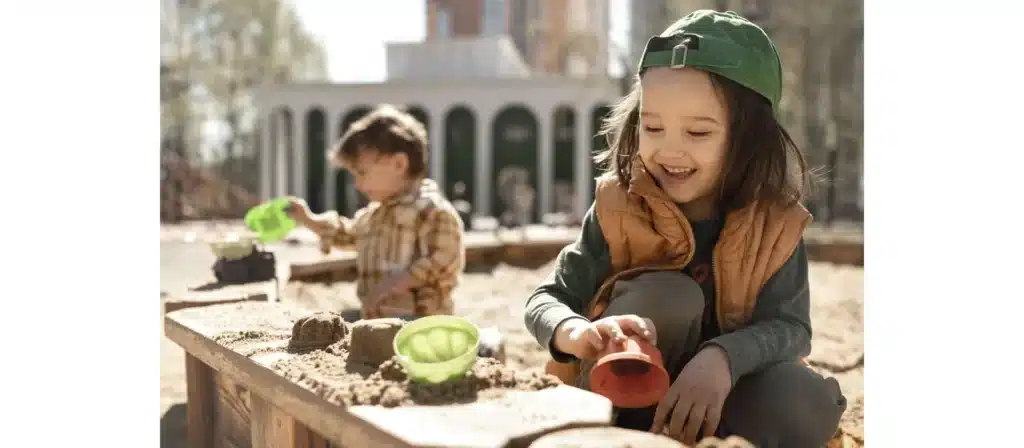
Visual Development:
Children’s ability to focus on objects and understand visual detail continues to improve. They become more adept at recognizing shapes, colors, and patterns.
- Typical Process:
- Improved ability to recognize and name colors, shapes, and familiar objects.
- Enhanced visual discrimination, such as identifying similarities and differences between objects.
- Better visual tracking and focus on moving objects.
- Activities to Promote Sensory Development:
- Engage in games that involve sorting objects by color or shape.
- Provide picture books with detailed illustrations and engage the child in identifying objects.
- Use puzzles to help the child refine their ability to recognize shapes and solve visual challenges.
Auditory Development:
At this age, children start to develop a better understanding of language. They recognize and respond to complex commands and sentences and can engage in simple conversations.
- Typical Process:
- Understand simple phrases and commands like “come here” or “give me the toy.”
- Can follow simple directions.
- Start to develop more varied speech patterns and use sentences.
- Activities to Promote Sensory Development:
- Play games like “Simon Says” to encourage listening and following directions.
- Engage the child in frequent storytelling, asking them to point to or name objects in pictures.
- Encourage them to sing along with simple songs or rhymes.
Taste Development:
Taste preferences are more defined, and children may resist unfamiliar flavors or textures.
- Typical Process:
- Increased preference for familiar foods.
- May start to resist new or unfamiliar foods, particularly those with strong flavors or unusual textures.
- Continue developing the ability to distinguish between different flavors.
- Activities to Promote Sensory Development:
- Offer a variety of textures in foods, such as crunchy, smooth, or chewy, to continue developing the sense of taste.
- Encourage trying new foods without pressure, allowing the child to explore at their own pace.
- Make food fun by letting the child help with preparing meals or offering food in creative ways.
Olfactory Development:
Children become more adept at recognizing and responding to different scents, associating certain smells with specific events or memories.
- Typical Process:
- Recognizes familiar smells and may react with joy or dislike.
- Can begin associating smells with events (e.g., cookies baking with family time).
- Stronger emotional responses to certain smells.
- Activities to Promote Sensory Development:
- Let the child explore natural scents, such as flowers, herbs, or fruits.
- Play games that involve identifying smells, like guessing the smell of different fruits or spices.
- Introduce scented toys or items (like lavender-scented pillows or herbal sachets).
Touch Development:
Children continue refining their fine motor skills, becoming more adept at manipulating objects and exploring textures. They also begin to interact with their environment in more purposeful ways.
- Typical Process:
- Increased ability to precisely manipulate objects (e.g., using a fork or building with blocks).
- Can differentiate between more subtle textures (e.g., rough versus smooth).
- Show interest in activities that require tactile engagement.
- Activities to Promote Sensory Development:
- Engage in crafts acticity that involve cutting, gluing, or coloring.
- Provide various sensory materials like playdough, sand, or textured fabric.
- Play with shape sorters, lacing cards, or stacking toys to refine fine motor skills.
Vestibular Development:
Children’s balance and coordination improve significantly at this age, and they gain more control over their movements. They enjoy activities that involve physical movement and movement challenges.
- Typical Process:
- Enjoy activities that involve running, jumping, and climbing.
- Can balance better and may jump with both feet off the ground.
- More confident in movements and spatial awareness.
- Activities to Promote Sensory Development:
- Encourage outdoor play such as running, jumping, or climbing.
- Set up obstacle courses that include crawling, climbing, and balancing.
- Dance to music or participate in activities that involve rhythmic movements.
Proprioception Development:
Children’s sense of body awareness continues to refine, and they gain more control over their physical movements.
- Typical Process:
- Improved coordination and ability to perform more complex movements (e.g., jumping, running, dancing).
- Increased awareness of their body in space, especially when completing physical tasks.
- Activities to Promote Sensory Development:
- Include jumping on a trampoline or playing hopscotch to refine coordination.
- Allow the child to climb, balance, and engage in physical play to strengthen proprioceptive awareness.
- Practice balancing on one foot or doing simple yoga poses.
3 to 4 years
Children are developing increasingly sophisticated cognitive, motor, and social skills at this stage. Their sensory systems are highly integrated, engaging more purposefully with their surroundings.
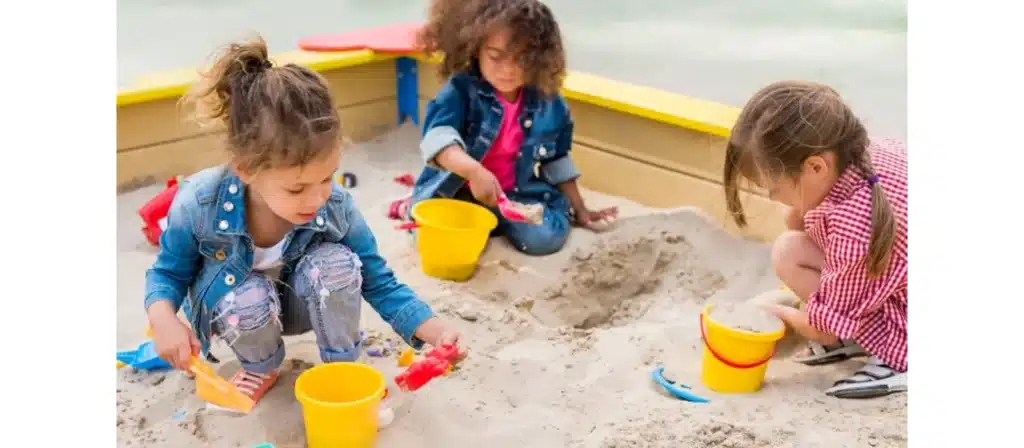
Visual Development:
Children refine their ability to focus on and recognize complex visual patterns, and their understanding of spatial relationships continues to grow.
- Typical Process:
- Can recognize and name common shapes, letters, and numbers.
- Improved ability to focus on and track moving objects across larger distances.
- Activities to Promote Sensory Development:
- Engage in activities like matching shapes, sorting objects by size or color, and simple puzzle-solving.
- Use picture books featuring familiar and unfamiliar objects to broaden their visual vocabulary.
Auditory Development:
Children begin to understand more complex instructions by age four and can engage in conversations more easily.
- Typical Process:
- Can follow multi-step instructions.
- Enjoys listening to stories and asking questions about the plot or characters.
- Activities to Promote Sensory Development:
- Encourage storytelling, asking the child to recount events from their day or a favorite story.
- Continue reading books with interactive elements that require listening and responding to questions.
Taste Development:
Taste continues to evolve, and children may resist new foods, though they are more willing to try certain flavors.
- Typical Process:
- Stronger preferences for certain foods, especially familiar ones.
- Increased ability to tolerate new flavors, although resistance may still occur.
- Activities to Promote Sensory Development:
- Introduce new foods gradually to reduce resistance.
- Let the child help prepare meals to encourage interest in trying new foods.
Olfactory Development:
Children develop a stronger connection between smell and memory. Certain smells may trigger specific responses or memories.
- Typical Process:
- Develop stronger associations between smell and experiences or emotions.
- May show a preference for certain scents and react negatively to others.
- Activities to Promote Sensory Development:
- Let the child help in the kitchen and explore food smells.
- Introduce activities like flower picking or scent-based sensory play.
Touch Development:
Children’s tactile skills become more refined, and they can increasingly precisely manipulate objects.
- Typical Process:
- Develop greater dexterity in using tools like scissors or crayons.
- Enhanced ability to differentiate between textures and use touch for tasks like sorting or organizing.
- Activities to Promote Sensory Development:
- Encourage activities like coloring, scissors, or drawing to refine fine motor skills.
- Provide opportunities for sensory play with materials like playdough or textured fabric.
Vestibular Development:
Children’s balance and coordination are further refined at this stage, allowing them to engage in more complex physical activities.
- Typical Process:
- Can run, jump, and engage in more complex physical movements.
- Improved coordination and balance during physical play.
- Activities to Promote Sensory Development:
- Set up obstacle courses that involve running, jumping, and balancing.
- Engage in games like hopping on one foot or playing tag to improve coordination.
Proprioception Development:
Children’s sense of body awareness continues to grow, and they gain more control over their actions.
- Typical Process:
- Develop better spatial awareness.
- Ability to control their body in space, such as jumping, climbing, or balancing.
- Activities to Promote Sensory Development:
- Play games that involve following movements (e.g., “Follow the Leader”).
- Encourage jumping, dancing, or playing on playground equipment to promote body awareness.
4 to 5 years
As children approach their fifth year, their sensory development is nearing maturity. They have a deeper understanding of their bodies and senses, allowing them to engage in more complex tasks and interactions.
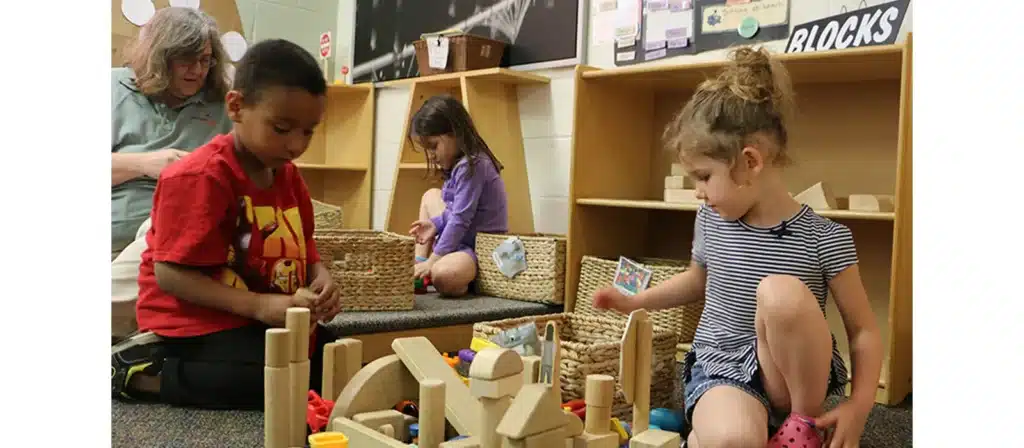
Visual Development:
Children now have a more sophisticated understanding of visual concepts, such as recognizing detailed patterns and spatial relationships.
- Typical Process:
- Accurately identifying letters, numbers, and common objects.
- Improved ability to understand size, distance, and patterns.
- Activities to Promote Sensory Development:
- Provide puzzles, pattern games, and memory-matching activities.
- Encourage reading and engaging in activities that involve visual discrimination.
Auditory Development:
Auditory processing continues to improve, and children can follow more detailed instructions and engage in deeper conversations.
- Typical Process:
- Can follow multi-step instructions with ease.
- Begin to understand more complex language concepts, such as time and emotions.
- Activities to Promote Sensory Development:
- Continue reading books together and discussing their content.
- Engage in listening games that challenge auditory discrimination (e.g., “Sound Bingo”).
Taste Development:
Taste becomes more individualized, and children develop more fixed preferences while continuing to explore new flavors.
- Typical Process:
- Strong preferences for certain foods but more willing to try new ones.
- Differentiate between more complex flavors, including spicy, sweet, sour, and salty.
- Activities to Promote Sensory Development:
- Introduce cooking activities where the child can experiment with mixing different ingredients.
- Encourage trying foods with varied textures and flavors to continue expanding their palate.
Olfactory Development:
Children continue refining their ability to recognize and differentiate between smells, creating stronger emotional connections with certain scents.
- Typical Process:
- May begin to associate specific scents with memories or events.
- Show more interest in pleasant, comforting smells.
- Activities to Promote Sensory Development:
- Explore natural environments and introduce the child to new scents, such as fresh herbs or flowers.
- Encourage them to create scent-based crafts or engage in activities like making scented playdough.
Touch Development:
The sense of touch is well-developed, and children can perform complex tasks that require tactile precision.
- Typical Process:
- Can use fine motor skills to complete detailed tasks, such as writing or drawing.
- Enhanced ability to manipulate small objects and complete tasks that require dexterity.
- Activities to Promote Sensory Development:
- Introduce more advanced arts and crafts projects that involve cutting, gluing, or drawing.
- Provide puzzles, building blocks, or other tactile toys to refine fine motor skills.
Vestibular Development:
Children’s vestibular sense is highly refined, and they can now perform complex physical tasks.
- Typical Process:
- Can run, jump, and balance with high proficiency.
- Enjoy activities that involve movement and coordination.
- Activities to Promote Sensory Development:
- Encourage outdoor play, such as biking, running, and climbing, to improve coordination and balance.
- Set up obstacle courses or playground activities that challenge their balance and movement.
Proprioception Development:
Body awareness and motor coordination are fully developed, enabling children to easily engage in more complex physical tasks.
- Typical Process:
- Improved coordination allows more complex tasks like jumping rope or riding a tricycle.
- Ability to move with precision and confidence.
- Activities to Promote Sensory Development:
- Encourage dancing, swimming, or running to improve motor control.
- Play games that involve following body movements or manipulating objects with precision.
Examples of Sensory Activities
Sensory activities engage children in using multiple senses to explore and interact with the world around them. These activities help stimulate and strengthen sensory pathways, enhancing cognitive, emotional, and physical development. Below are a few examples of sensory activities:
- Sensory Bins: Fill a bin with rice, sand, or water, and include small toys, blocks, or scoops. This stimulates touch and helps children with tactile exploration.
- Listening Games: To encourage auditory development, play games with different sounds (e.g., bells, rattles, musical instruments).
- Taste Testing: Introduce different textures and flavors through fruits, vegetables, or snacks to stimulate taste.
- Smell Exploration: Use essential oils or flowers to expose children to various smells, helping develop olfactory senses.
- Art and Crafts: Let children engage in painting, coloring, or sculpting to develop fine motor skills and tactile senses.
- Balance and Movement: Activities like jumping, swinging, or climbing help children engage their vestibular senses and improve balance.
How Does Sensory Play Promote Development?
Sensory play involves activities that engage one or more of the child’s senses. These activities are fun and promote healthy development in multiple areas.
- Motor Skills
Sensory play activities like finger painting, playing with sand, or jumping on a trampoline help children develop fine and gross motor skills. These activities encourage hand-eye coordination, balance, and muscle strength. - Language Skills
Engaging in sensory play helps children develop language skills. Sensory-rich environments, like water tables or sensory bins, allow children to use descriptive language as they talk about textures, colors, and objects they interact with. - Cognitive Skills
Children begin to understand concepts like cause and effect by engaging in sensory play. Pouring water into different containers teaches them about volume and measurement while playing with puzzle pieces helps with problem-solving and spatial reasoning. - Social Skills
Sensory play also fosters social skills. When children engage in group activities, such as building a sandcastle or sharing sensory toys, they learn cooperation, turn-taking, and conflict resolution.
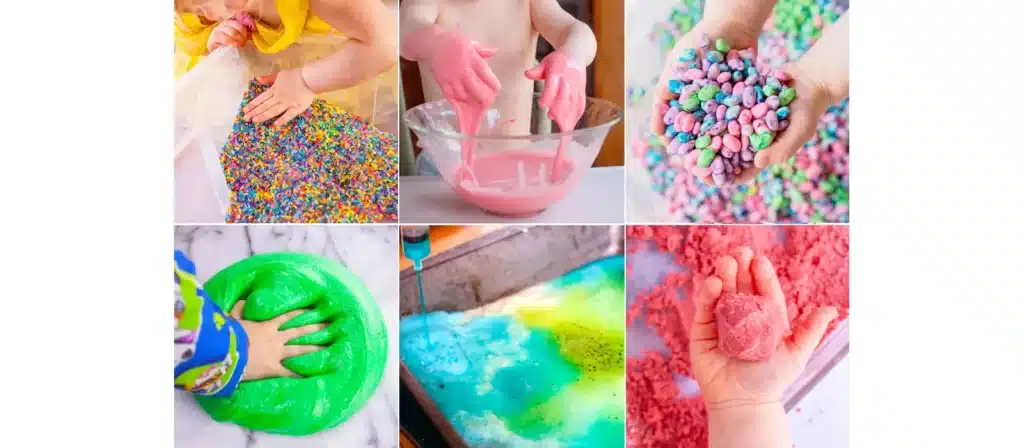
Why is Play-Based Learning Beneficial for Sensory Development?
Play-based learning is one of the most effective ways to promote sensory development. Through play, children engage their senses in a natural and enjoyable way, stimulating their brain and body. Play-based activities not only help children develop sensory skills but also promote creativity, critical thinking, and emotional regulation.
During play, children encounter various sensory experiences, from touching different textures to listening to various sounds, all of which contribute to strengthening their sensory processing abilities. Moreover, play fosters social interaction, problem-solving skills, and the ability to adapt to new situations, all essential for healthy child development.

How to Help Encourage Sensory Development?
Supporting sensory development in children requires a well-rounded approach, incorporating different environments that stimulate and challenge their senses. Whether it’s time spent outdoors, on the playground, or in the classroom, each setting offers unique benefits for enhancing sensory processing. Incorporating sensory-rich activities throughout the day and adapting environments to be sensory-friendly helps children develop stronger sensory integration skills.
Nature is the Ideal Classroom
The natural world provides abundant sensory experiences that significantly aid sensory development. The textures of leaves, the sounds of birds, and the smells of fresh air all stimulate sensory exploration. Time spent in nature allows children to develop their sensory processing skills in a dynamic, interactive environment.
- Encourages tactile experiences with different textures (rocks, trees, soil).
- Provides a variety of auditory stimuli (wind, birds, water).
- Enhances proprioception and vestibular awareness through climbing or walking.
On the Playground
The playground is ideal for children to engage in physical and sensory play. Swinging, sliding, climbing, and running allow children to strengthen their vestibular and proprioceptive senses. These activities promote balance, coordination, and body awareness, essential for sensory integration.
- Improves balance and coordination through physical activities like climbing and swinging.
- Encourages tactile exploration through different surfaces (sand, grass, or rubber).
- Boosts sensory processing skills through social interaction and play with peers.
In the Classroom
The classroom is a controlled environment that can be tailored to stimulate a child’s senses differently. Materials like textured mats, scented markers, or auditory devices can simultaneously engage multiple senses, encouraging more effective sensory processing. Teachers can also incorporate sensory breaks to help children manage overstimulation and maintain focus throughout the school day.
- Provides controlled sensory experiences through educational tools and materials.
- Helps regulate sensory input through structured sensory breaks.
- Encourages focus and attention with the use of visual and auditory learning tools.
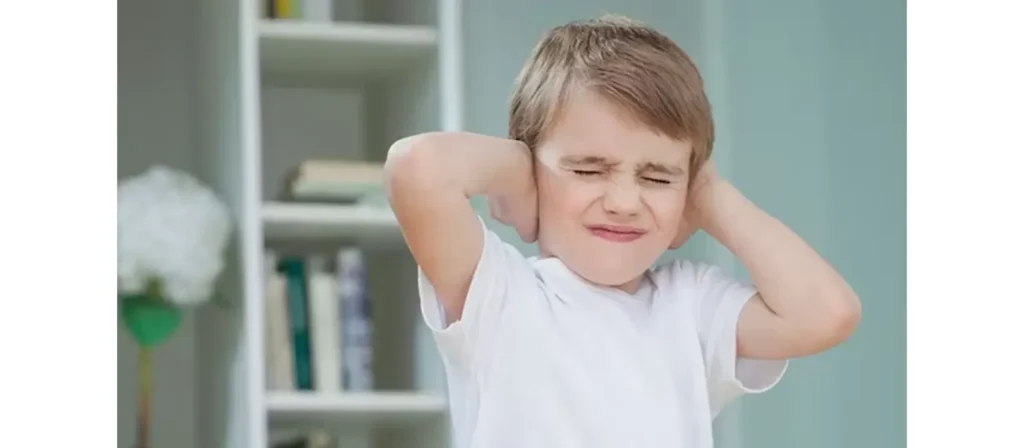
Signs of Sensory Processing Disorder
Sensory Processing Disorder (SPD) occurs when the brain has difficulty processing and responding to sensory information. Children with SPD may have an overactive or underactive response to sensory stimuli, impacting their behavior and daily functioning.
Signs of SPD include:
- Over-Responsiveness to Sensory Stimuli: A child may become easily overwhelmed by bright lights, loud noises, or certain textures. They may avoid certain foods or activities due to sensory sensitivities.
- Under-Responsiveness to Sensory Input: A child may not react to pain, temperature, or sensory stimuli in a typical way. They may seek intense sensory experiences, such as excessive touching or spinning.
- Difficulty with Coordination and Balance: Children may struggle with tasks that require fine motor skills, such as using utensils or tying shoelaces, or they may have difficulty with balance and spatial awareness.
- Emotional and Behavioral Challenges: Children with SPD may become frustrated or anxious when overwhelmed by sensory input and may struggle with emotional regulation.

Support and Treatment for Sensory Processing Disorder
Early intervention is key when addressing Sensory Processing Disorder (SPD). Children can develop more effective strategies for managing sensory challenges with the right support.
Treatment Options Include:
- Occupational Therapy (OT): An occupational therapist can develop individualized programs to help children appropriately manage sensory overload or seek sensory input.
- Sensory Integration Therapy: This therapy aims to help children process sensory information more efficiently through structured activities.
- Environment Modifications: Creating a sensory-friendly environment, such as noise-canceling headphones, soft lighting, or textured materials, can help children manage sensory input.
- Parent and Teacher Training: Educators and parents can learn strategies to help children with SPD thrive in home and school environments.
By understanding SPD and offering the right interventions, children can improve their sensory processing and develop the skills necessary for learning and socializing.
Frequently Asked Questions (FAQs)
- How can sensory development be promoted at home?
Parents can promote sensory development by providing opportunities for children to explore different textures, colors, sounds, and smells through everyday activities and toys. - What are some signs that a child may have sensory processing issues?
Signs include becoming easily overwhelmed by sensory stimuli, avoiding certain textures or foods, or exhibiting unusual behaviors such as seeking excessive sensory input. - At what age does sensory development start?
Sensory development begins at birth and continues to evolve through the early childhood years. - How do sensory experiences impact a child’s emotional well-being?
Sensory experiences can help regulate emotions by providing comfort or excitement. Sensory overload or underload, however, can lead to stress and emotional difficulties. - Can sensory processing issues affect a child’s learning ability?
Yes, sensory processing issues can affect focus, memory, and behavior, making it difficult for children to engage in learning activities. - How can sensory play help with child development?
Sensory play enhances cognitive, emotional, and social development by stimulating the child’s senses. It promotes creativity, problem-solving, and motor skills while fostering a deeper understanding of the world. - How does sensory processing disorder (SPD) affect a child’s development?
Children with SPD may struggle to process sensory information effectively, leading to challenges with everyday tasks, social interactions, and emotional regulation. Early intervention and sensory-based therapies can help manage SPD. - Is sensory development the same as cognitive development?
While sensory development is closely linked to cognitive development, they are not the same. Sensory development focuses on how children interact with their environment through their senses, while cognitive development encompasses a broader range of intellectual abilities, including reasoning, problem-solving, and memory.
Conclusion
Sensory development in early childhood is a vital part of a child’s overall growth and well-being. Understanding the importance of sensory experiences, recognizing developmental challenges, and implementing strategies to support sensory growth can lead to more engaged, healthy, and capable children. By creating supportive, sensory-rich environments at home and school, parents and educators can ensure children develop the skills they need to thrive in all areas of life.

